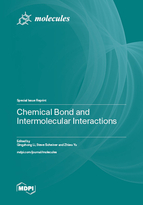Chemical Bond and Intermolecular Interactions
A special issue of Molecules (ISSN 1420-3049). This special issue belongs to the section "Molecular Structure".
Deadline for manuscript submissions: closed (15 December 2022) | Viewed by 16435
Special Issue Editors
Interests: intermolecular interactions; theoretical calculations; tetrel bonds; triel bonds; molecular spectroscopy
Special Issues, Collections and Topics in MDPI journals
Interests: H-bonds; noncovalent bonds; halogen bonds; pnicogen bonds; tetrel bonds
Special Issues, Collections and Topics in MDPI journals
Interests: molecular spectroscopy; hydrogen bonds; halogen bonds; molecular structures; phospholipids
Special Issues, Collections and Topics in MDPI journals
Special Issue Information
Dear Colleagues,
This Special Issue focuses on the geometrical and spectroscopic features as well as potential applications of halogen, chalcogen, pnictogen, tetrel, and triel bonds in chemical reactions, crystal engineering, molecular recognition, and biological systems. We aim to especially publish studies concerning the bonds formed between some novel important electron donors and acceptors, similarities and differences between these bonds, structures of the complexes composed of these bonds in solution and gas phases, spectroscopic methods for measuring these bonds in solution and gas phases, and applications of these bonds in chemical reactions, crystal engineering, molecular recognition, and biological systems.
Prof. Dr. Qingzhong Li
Prof. Dr. Steve Scheiner
Prof. Dr. Zhiwu Yu
Guest Editors
Manuscript Submission Information
Manuscripts should be submitted online at www.mdpi.com by registering and logging in to this website. Once you are registered, click here to go to the submission form. Manuscripts can be submitted until the deadline. All submissions that pass pre-check are peer-reviewed. Accepted papers will be published continuously in the journal (as soon as accepted) and will be listed together on the special issue website. Research articles, review articles as well as short communications are invited. For planned papers, a title and short abstract (about 100 words) can be sent to the Editorial Office for announcement on this website.
Submitted manuscripts should not have been published previously, nor be under consideration for publication elsewhere (except conference proceedings papers). All manuscripts are thoroughly refereed through a single-blind peer-review process. A guide for authors and other relevant information for submission of manuscripts is available on the Instructions for Authors page. Molecules is an international peer-reviewed open access semimonthly journal published by MDPI.
Please visit the Instructions for Authors page before submitting a manuscript. The Article Processing Charge (APC) for publication in this open access journal is 2700 CHF (Swiss Francs). Submitted papers should be well formatted and use good English. Authors may use MDPI's English editing service prior to publication or during author revisions.
Keywords
- halogen bond
- chalcogen bond
- pnictogen bond
- tetrel bond
- triel bond









